新视野大学英语第三册第五单元教案
- 格式:doc
- 大小:114.50 KB
- 文档页数:8
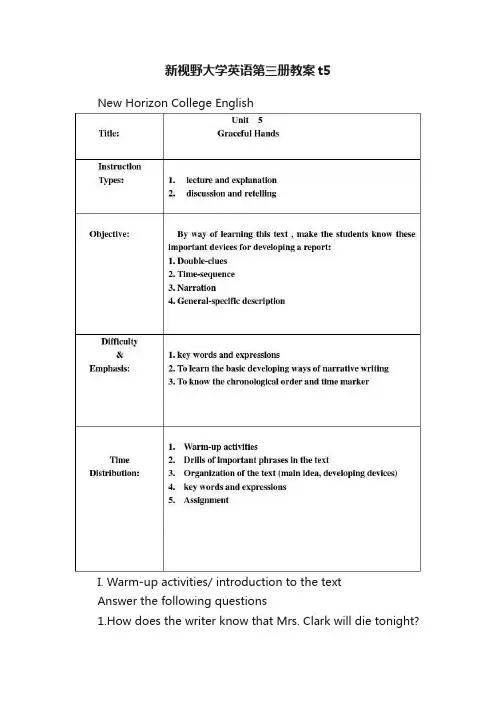
新视野大学英语第三册教案t5New Horizon College EnglishI. Warm-up activities/ introduction to the textAnswer the following questions1.How does the writer know that Mrs. Clark will die tonight?The writer gets to know it from Mrs. Clark’s medical chart and the report she received from the preceding shift.2.Why did Mrs. Clark send her family home that night?Because she didn’t want them to suffer from the experience of seeing her die.3.What does the writer mean by saying that both she and Mrs. Clark become aware that this is aspecial moment between two human beings?She means that they both realize that Mrs. Clark is dying and as human beings this is an unavoidable and very special moment.4.Why does the writer notice and mention Mrs. Clark’s fingers several times?Because Mrs. Clark’s fingers are very long and graceful, which catch the writer’s eyes easily. At the end of the passage we get to know that she was a concert piano player and a piano teacher for over thirty years. No wonder she has such long and graceful fingers that are suitable for playing piano.II. Drills of important phrases in the text1. 医疗记录medical chart 2.医疗设备medical equipment3.用无动于衷的、医生的目光观察着病人to observe the patient with an unemotional, medical eye 4.奄奄一息to be dying 5.骨瘦如柴的身体 a skeleton body 6.随着不均匀的呼吸一起一伏to rise and fall with the uneven breaths7.感觉那微弱的脉搏to feel for the faint pulse 8.缓解她的干渴to ease her thirst 9.尽力(没有用力)去干某事to make (no)attempt to do sth.10.开始做她所需要to go about providing for her needs.11.把某人抱起来to pick sb. up in one’s arms 12. 打开护肤霜的瓶盖,揩了一些在手心to remove the lid from a jar of skin cream and put some on the palm of my hand13. 把护肤霜揉在她发黄的皮肤上to rub cream into the yellow skin14. 她读懂/看穿了我的心思/善解人意She is a mind reader. She senses my thoughts. 15.耗尽了最后的那点力气to spend her last ounce of strength 16.时间似乎停滞了Time seems to stand still 17.我感觉自己的脉搏加快了。

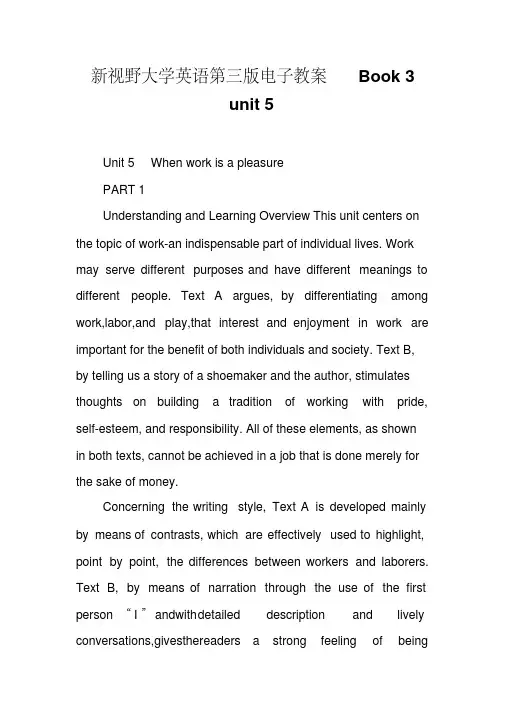
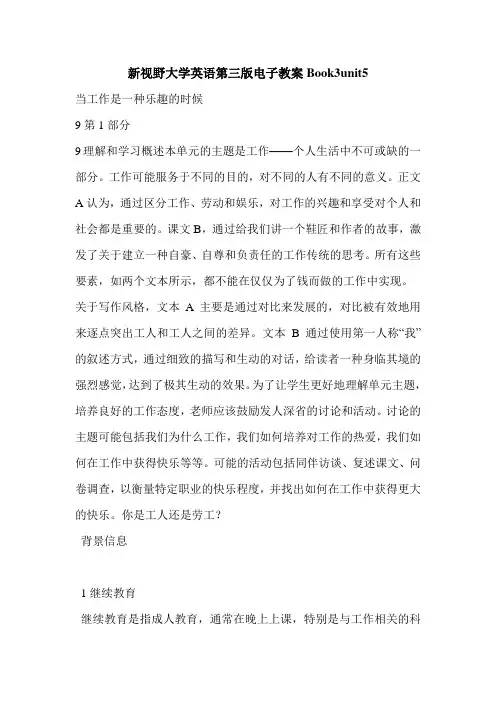
新视野大学英语第三版电子教案Book3unit5当工作是一种乐趣的时候9第1部分9理解和学习概述本单元的主题是工作——个人生活中不可或缺的一部分。
工作可能服务于不同的目的,对不同的人有不同的意义。
正文A认为,通过区分工作、劳动和娱乐,对工作的兴趣和享受对个人和社会都是重要的。
课文B,通过给我们讲一个鞋匠和作者的故事,激发了关于建立一种自豪、自尊和负责任的工作传统的思考。
所有这些要素,如两个文本所示,都不能在仅仅为了钱而做的工作中实现。
关于写作风格,文本A主要是通过对比来发展的,对比被有效地用来逐点突出工人和工人之间的差异。
文本B通过使用第一人称“我”的叙述方式,通过细致的描写和生动的对话,给读者一种身临其境的强烈感觉,达到了极其生动的效果。
为了让学生更好地理解单元主题,培养良好的工作态度,老师应该鼓励发人深省的讨论和活动。
讨论的主题可能包括我们为什么工作,我们如何培养对工作的热爱,我们如何在工作中获得快乐等等。
可能的活动包括同伴访谈、复述课文、问卷调查,以衡量特定职业的快乐程度,并找出如何在工作中获得更大的快乐。
你是工人还是劳工?背景信息1继续教育继续教育是指成人教育,通常在晚上上课,特别是与工作相关的科目。
2体验式学习体验式学习是从直接经验中创造意义的过程。
它是通过对做的反思来学习,这是由死记硬背来控制的。
19919体验式学习的例子是去动物园,通过观察和与动物园环境的互动来学习,而不是从书中阅读关于动物的内容。
因此,一个人用第一手知识进行发现和实验,而不是听或读别人的经历。
在一个严格意义上的奴隶制已经被废除的社会中,围绕工作的社会条件、工作的价值和工资,已经使许多劳动者沦为现代奴隶——“雇佣奴隶”。
(第106段)。
1)含义:在一个严格意义上已经结束奴隶制的社会里,工作的社会地位,工作的价值和工资,何说,中国政府将继续贯彻“一国两制”的方针。
监考老师警告学生不要在考试中作弊,以免他们侮辱自己。
注这里的“工资奴隶”是指那些仅仅为了赚取工资而工作的人。
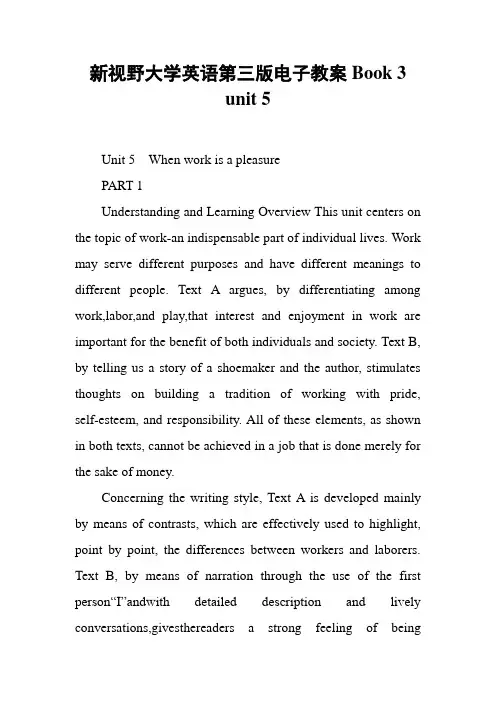
新视野大学英语第三版电子教案Book 3unit 5Unit 5 When work is a pleasurePART 1Understanding and Learning Overview This unit centers on the topic of work-an indispensable part of individual lives. Work may serve different purposes and have different meanings to different people. Text A argues, by differentiating among work,labor,and play,that interest and enjoyment in work are important for the benefit of both individuals and society. Text B, by telling us a story of a shoemaker and the author, stimulates thoughts on building a tradition of working with pride, self-esteem, and responsibility. All of these elements, as shown in both texts, cannot be achieved in a job that is done merely for the sake of money.Concerning the writing style, Text A is developed mainly by means of contrasts, which are effectively used to highlight, point by point, the differences between workers and laborers. Text B, by means of narration through the use of the first person“I”andwith detailed description and lively conversations,givesthereaders a strong feeling of beingpersonally on the scene,and achieves the effect of great vividness.In order for students to get a strong understanding ofthe unit theme and foster a good attitude toward work,the teacher should encourage thought-provoking discussions and activities. The topics for the discussions may includewhy we work, how we can foster love for work, how we achieve happiness at work, are peer interviews,retellingof Text B, questionnaire survey to gauge thehappiness level of a specific occupation and towork out how to achieve greater happiness at work.Section A Will you be a worker or a laborBackground information1 continuing educationContinuing education refers to the education for adults, usually in classes that are held in the evening and especially on subjects that are related to their jobs.2 experiential learningExperiential learning is the process of making meaning from direct experience. It is learning through reflection on doing, which is often contrasted with rote learning (死记硬背). Experiential learning focuses on the learning process for the individua1. An1example of experiential learning is going to the zoo and learning through observation and interaction with the zoo environment, as opposed to reading about animals from a book. Thus, one makes discoveries and experiments with knowledge firsthand, instead of hearing or reading about others’ experiences.Detailed study of the text1 In a society where slavery in the strict sense has been abolished, the socialindications around work,the value of work and the salary, have degraded many laborers into modern slaves-“wage slaves”.(Para. 1)Meaning: In a society where slavery, strictly speaking, has been put to an end, the social status of work, the value of work and the salary, have made many laborersbexxe modern slaves-“wage slaves”.★degrade:vt. treat sb. without respect and make them lose respect for themselves贬低(某人);羞辱(某人)The examination supervisor warned students not to degrade themselves by cheating on the exam.监考老师警告学生不要在考试中舞弊,以免自取其辱。

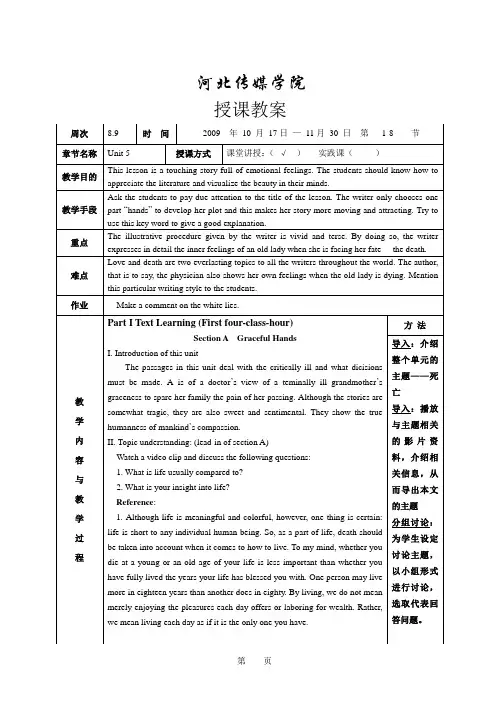
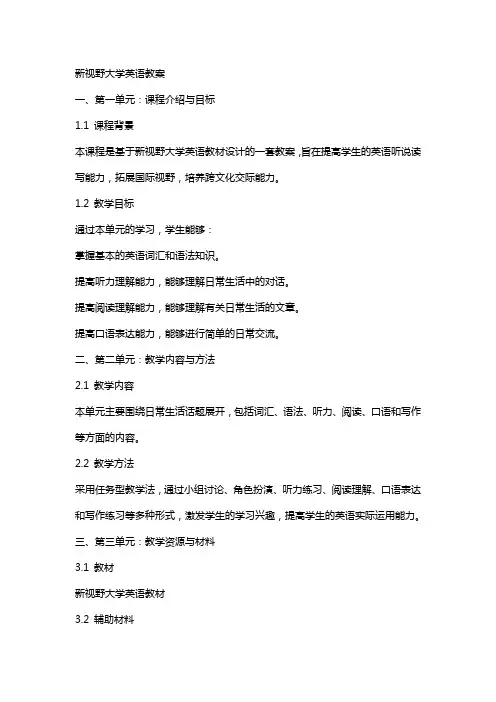
新视野大学英语教案一、第一单元:课程介绍与目标1.1 课程背景本课程是基于新视野大学英语教材设计的一套教案,旨在提高学生的英语听说读写能力,拓展国际视野,培养跨文化交际能力。
1.2 教学目标通过本单元的学习,学生能够:掌握基本的英语词汇和语法知识。
提高听力理解能力,能够理解日常生活中的对话。
提高阅读理解能力,能够理解有关日常生活的文章。
提高口语表达能力,能够进行简单的日常交流。
二、第二单元:教学内容与方法2.1 教学内容本单元主要围绕日常生活话题展开,包括词汇、语法、听力、阅读、口语和写作等方面的内容。
2.2 教学方法采用任务型教学法,通过小组讨论、角色扮演、听力练习、阅读理解、口语表达和写作练习等多种形式,激发学生的学习兴趣,提高学生的英语实际运用能力。
三、第三单元:教学资源与材料3.1 教材新视野大学英语教材3.2 辅助材料多媒体教学课件、音频文件、视频文件、练习册、单词卡片等。
四、第四单元:教学评估与反馈4.1 评估方式通过课堂表现、作业完成情况、听力测试、阅读测试、口语测试和写作测试等多种方式进行评估。
4.2 反馈机制教师将对学生的学习情况进行及时反馈,包括对学生的课堂表现、作业完成情况、听力测试、阅读测试、口语测试和写作测试等进行评价和指导,帮助学生提高英语水平。
五、第五单元:教学计划与安排5.1 教学计划本单元的教学计划分为两个阶段:第一阶段为课堂讲授和练习,第二阶段为课后作业和自主学习。
5.2 教学安排第1-2周:词汇和语法学习。
第3-4周:听力训练。
第5-6周:阅读理解训练。
第7-8周:口语表达训练。
第9-10周:写作训练。
六、第六单元:听力教学策略6.1 教学目标通过本单元的学习,学生能够:提高听力理解能力,能够理解日常生活中的对话。
掌握听力技巧,提高听力水平。
6.2 教学内容本单元主要围绕听力技巧和日常生活对话展开,包括听力策略、听力技巧训练和日常生活对话练习等内容。
6.3 教学方法采用任务型教学法,通过听力练习、小组讨论、角色扮演等形式,激发学生的学习兴趣,提高学生的听力理解能力。
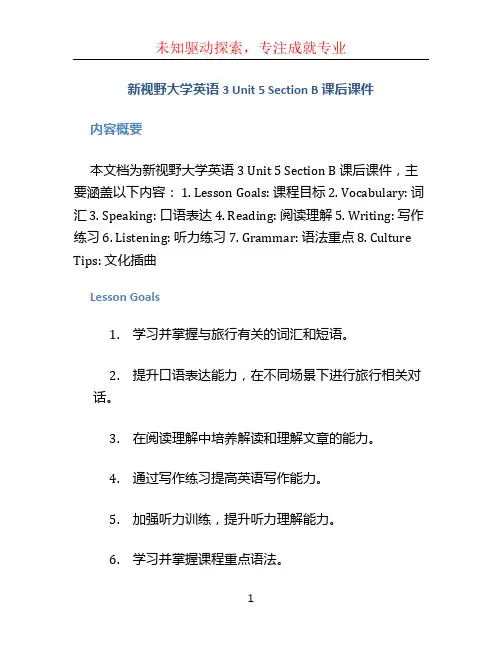
新视野大学英语3 Unit 5 Section B 课后课件内容概要本文档为新视野大学英语3 Unit 5 Section B 课后课件,主要涵盖以下内容: 1. Lesson Goals: 课程目标 2. Vocabulary: 词汇 3. Speaking: 口语表达 4. Reading: 阅读理解 5. Writing: 写作练习 6. Listening: 听力练习 7. Grammar: 语法重点 8. Culture Tips: 文化插曲Lesson Goals1.学习并掌握与旅行有关的词汇和短语。
2.提升口语表达能力,在不同场景下进行旅行相关对话。
3.在阅读理解中培养解读和理解文章的能力。
4.通过写作练习提高英语写作能力。
5.加强听力训练,提升听力理解能力。
6.学习并掌握课程重点语法。
Vocabulary•travel: 旅行•destination: 目的地•luggage: 行李•itinerary: 行程表•accommodation: 住宿•transportation: 交通工具•sightseeing: 观光•souvenir: 纪念品•guidebook: 导游手册•passport: 护照SpeakingTask 1: 与伙伴进行旅行相关的对话根据提供的对话情景,与你的伙伴进行对话练习。
包括以下情景: - 询问旅行计划 - 回答对旅行方式的喜好 - 讨论旅行目的地 - 咨询住宿和交通方式 - 讨论旅行中的活动和观光ReadingPassage 1: Trip to Paris阅读以下文章,然后根据问题回答问题。
Paris, the capital city of France, is a popular destination for travelers all over the world. With its rich history, beautiful architecture, and famous landmarks such as the Eiffel Tower and Louvre Museum, visitors can immerse themselves in the cultural and artistic atmosphere.If you are planning a trip to Paris, here are a few things you should know. First, make sure to visit the famous attractions, such as the Eiffel Tower, Notre Dame Cathedral, and Champs-Élysées. These landmarks represent the spirit and essence of Paris.Second, don’t miss out on the exquisite Fren ch cuisine. From croissants and baguettes to cheese and wine, French food is known for its taste and variety. Try visiting a local café or restaurant to experience the authentic flavors of Paris.Lastly, explore the charming streets and neighborhoods of Paris. Take a walk along the Seine River, visit Montmartre and its famous Sacré-Cœur Basilica, or wander through the artistic district of Le Marais. You will be captivated by the beauty and charm of the city.Questions: 1. What is Paris known for? 2. Name three famous landmarks in Paris. 3. What is special about French cuisine? 4. Name two neighborhoods in Paris that are worth exploring.Passage 2: Travel TipsTraveling can be exciting and fun, but it requires careful planning and preparation. Here are some useful travel tips to make your trip more enjoyable and stress-free.First, make a detailed itinerary. Plan your days and activities in advance so that you can make the most of your trip. Research about the destination, including the local customs, transportation options, and must-see attractions.Second, pack your luggage wisely. Make a checklist of essential items and pack them according to the weather and duration of your trip. Don’t forget to bring important documents such as your passport, identification cards, and travel insurance.Next, book your accommodation in advance. Whether you prefer a hotel, hostel, or vacation rental, make sure to make reservations early to secure the best deals and availability. Consider the location, amenities, and customer reviews when making your choice.During your trip, be mindful of your belongings and personal safety. Keep your valuables secure and be cautious of your surroundings. Avoid carrying large amounts of cash and use digital payment methods whenever possible.Lastly, immerse yourself in the local culture. Try the local cuisine, interact with the locals, and learn a few common phrases in the local language. Respect the local customs and traditions, and be a responsible traveler.Questions: 1. What should you do before traveling? 2. What should you pack for your trip? 3. Why is it important to book your accommodation in advance? 4. What tips are given for ensuring personal safety during the trip?WritingTask: Write a Travel Blog PostImagine that you have just returned from a trip to a fascinating destination. Write a travel blog post to share your experience with others. Include the following points: - Brief introduction of the destination - Highlights of the trip and places you visited - Interesting experiences or activities during the trip - Local cuisine and food you tried - Overall impression and recommendation for future travelersListeningListen to the audio clips and answer the following questions:1.What mode of transportation is the speakerreferring to?2.Where is the speaker planning to visit?3.What is the weather like in the destination?4.What activities does the speaker mention?GrammarPast Continuous TenseThe past continuous tense is used to describe actions that were happening in the past at a specific point or a continuous period. In most cases, it is used alongside the past simple tense to provide a complete picture of the past events.Structure:•Positive form: Subject + was/were + verb(-ing)•Negative form: Subject + was/were not + verb(-ing)•Question form: Was/Were + subject + verb(-ing) Example sentences:•I was studying when the phone rang.•They were playing soccer while it was raining.•Were you watching TV when I called?Culture TipsSouvenirs from Around the WorldWhen traveling to a new destination, many people like to bring back souvenirs as a memento of their trip. Here are some popular souvenirs from around the world:1.Eiffel Tower keychain from Paris, France2.Matryoshka dolls from Russia3.Hand-painted ceramics from Spain4.Kimono from Japan5.Alpaca wool products from Peru6.Maple syrup from Canada7.Traditional masks from AfricaEach of these souvenirs represents the unique culture and traditions of the respective country. They can make great giftsor personal keepsakes from your travels.结语通过本文档的学习,你将学到与旅行相关的词汇和短语,提升口语表达能力,在阅读理解中培养解读和理解文章的能力,通过写作练习提高英语写作能力,加强听力训练和掌握课程重点语法。

教学对象:大学三年级学生教学目标:1. 理解并掌握文章的主旨大意。
2. 掌握并运用文章中的重点词汇和短语。
3. 提高学生的阅读理解能力和英语写作能力。
教学内容:1. 文章背景介绍2. 文章结构分析3. 重点词汇和短语讲解4. 阅读理解练习5. 写作指导教学步骤:一、导入(5分钟)1. 教师简要介绍文章背景,激发学生的兴趣。
2. 学生分享自己对文章主题的理解。
二、文章结构分析(10分钟)1. 教师引导学生分析文章结构,包括引言、正文和结论。
2. 学生分组讨论,总结每个部分的主要内容。
三、重点词汇和短语讲解(15分钟)1. 教师讲解文章中的重点词汇和短语,如:stereotype、culture、values等。
2. 学生跟读并模仿例句,加深对词汇和短语的理解。
四、阅读理解练习(15分钟)1. 教师组织学生进行阅读理解练习,包括选择题、判断题和简答题。
2. 学生独立完成练习,教师巡视指导。
五、写作指导(15分钟)1. 教师讲解写作技巧,如:如何展开段落、如何运用过渡词等。
2. 学生根据所学内容,撰写一篇关于文化价值观的短文。
六、课堂总结(5分钟)1. 教师总结本节课的学习内容,强调重点。
2. 学生分享自己的学习心得。
教学评价:1. 学生能够正确理解文章主旨大意。
2. 学生能够熟练运用文章中的重点词汇和短语。
3. 学生能够根据所学内容,撰写一篇关于文化价值观的短文。
教学反思:1. 本节课注重培养学生的阅读理解能力和英语写作能力。
2. 教师应关注学生的个体差异,给予针对性的指导。
3. 在教学过程中,教师应注重激发学生的兴趣,提高学生的学习积极性。
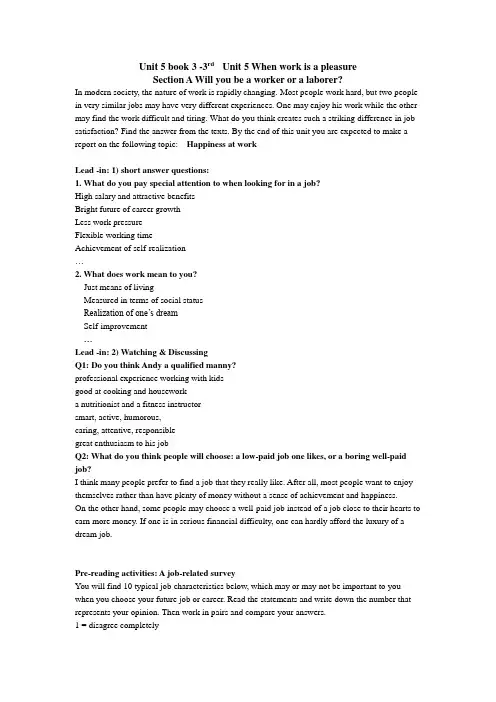
Unit 5 book 3 -3rd Unit 5 When work is a pleasureSection A Will you be a worker or a laborer?In modern society, the nature of work is rapidly changing. Most people work hard, but two people in very similar jobs may have very different experiences. One may enjoy his work while the other may find the work difficult and tiring. What do you think creates such a striking difference in job satisfaction? Find the answer from the texts. By the end of this unit you are expected to make a report on the following topic: Happiness at workLead -in: 1) short answer questions:1. What do you pay special attention to when looking for in a job?High salary and attractive benefitsBright future of career growthLess work pressureFlexible working timeAchievement of self-realization…2. What does work mean to you?Just means of livingMeasured in terms of social statusRealization of one’s dreamSelf-improvement…Lead -in: 2) Watching & DiscussingQ1: Do you think Andy a qualified manny?professional experience working with kidsgood at cooking and houseworka nutritionist and a fitness instructorsmart, active, humorous,caring, attentive, responsiblegreat enthusiasm to his jobQ2: What do you think people will choose: a low-paid job one likes, or a boring well-paid job?I think many people prefer to find a job that they really like. After all, most people want to enjoy themselves rather than have plenty of money without a sense of achievement and happiness.On the other hand, some people may choose a well-paid job instead of a job close to their hearts to earn more money. If one is in serious financial difficulty, one can hardly afford the luxury of a dream job.Pre-reading activities: A job-related surveyYou will find 10 typical job characteristics below, which may or may not be important to you when you choose your future job or career. Read the statements and write down the number that represents your opinion. Then work in pairs and compare your answers.1 = disagree completely2 = agree a little3 = agree to some extent4 = mostly agree5 = agree completelyWhen exploring a job, it is important for me to know …□ 1. the chance of advancing to a higher position□ 2. how much the job pays□ 3. how much responsibility the job involves□ 4. the s tress level of the job□ 5. the location of the office building□ 6. the work conditions□ 7. whether the job requires unusual work hours□ 8. the amount of travel required□ 9. whether the job fits my personality□ 10. whether people consider the j ob prestigiousDiscuss the following question with your partner.What are the three most important factors when you choose a job?Reference answers:There are many things to consider when people are choosing a career. But for me, the following three factors affect my choice most. First, the job must fit my personality. I believe that certain occupations are more suitable for particular personality types than others. If the job really fits my personality, I will be more likely to be successful and enjoy working.Second, how much the job pays. It is understandable that if I want to live an adequate life, I need to make enough money to support that kind of life. Finally, the location of the office building is also an important factor in choosing a career for m e. I don’t like a job located far away from my home, because it requires extra commute time and will surely reduce the time with my family.Try to translate this letter of resignation into English.1) What did she mean in this letter?She probably meant that she would take time to truly feel thebeauty of life and the world.2) Why do you think she quitted her job?The reasons of her resignation vary. It can be caused byexcessive workload, unfair treatment or her desire forfreedom.Background InformationContinuing EducationContinuing education (similar to further education in the UnitedKingdom and Ireland) is an all- encompassing term within abroad list of post-secondary learning activities and programs. The term is used mainly in the United States and parts of Canada. Recognized forms of post-secondary learning activities within the domain include: degree credit courses by non-traditional students, non-degree career training, workforce training, formal personal enrichment courses (both on-campus and online), self-directed learning (such as through Internet interest groups, clubs or personal research activities) andexperiential learning as applied to problem solving.Experiential LearningExperiential learning is theprocess of making meaning from direct experience. It is learning through reflection on doing, which is often contrasted with rote learning(死记硬背). Experiential learning focuses on the learning process for the individual. An example of experiential learning is going to the zoo and learning through observation and interaction with the zoo environment, as opposed to reading about animals from a book. Thus, one makes discoveries and experiments with knowledge firsthand, instead of hearing or reading about others’ experiences.DiscussionHow does technology change people’s work and life?Since the dawn of time, humans have developed tools and technology to assist in the pursuit of their goals. Large shifts in technology have resulted in large shifts in social structures, and in how individuals both contribute to society and make a living. Today, advances in technology are rapidly making it possible to automate much of the work currently carried out by humans. This applies not only to blue-collar jobs through robotics and the Internet of Things, but also towhite-collar work through artificial intelligence. The wide applicability of these technologies has led to broad concern about thedestruction of jobs. Indeed, according to a 2014 Oxford study, 47% of jobs in the US could be replaced by automated processes in the next two decades. Of course, while technology has always removed the need for some types of jobs, as many havenoticed, it also creates new ones. Nine of the top ten most in-demand jobs in the latest years did not exist in 2003, suggesting that the latest technological revolution is creating new employment opportunities.On the other hand, people are working harder and are more enslaved to their work than before. More people are seen walking around with laptops or smartphones. They’re becoming slaves to high technology. So it’s not high-tech, but kind of high-shackles or high-manacles. Unfortunately, there’s no escape.How can you foster love for your work?In general, it is hard to foster love for your work, especially if you get bored with your work or if you do not feel appreciated. So if you find it hard to love what you do, there are several ways for you to develop a more positive attitude towards work. With time and effort, you may start to find that you are looking forward to work rather than dreading it.Step 1: Change the way you work. When work becomes mundane, it can feel more difficult to face. In these situations, it might be helpful to change your approach. This is sometimes called job enrichment.Step 2: Focus on the positive aspects of your job. If you are not enjoying your job, you usually tend to focus your mind on all of the negative aspects of it. To reverse the trend, you need to identify what you like about your job and start focusing on those positive aspects instead.Step 3: Practice gratitude. If you have negative thoughts about going to work each day, try keeping a list of the things that you are grateful for. Practicing gratitude can help you to feel happier overall and may also help you see your job in a more positive light.Step 4: Look at the big picture. Sometimes work may become a chore if little things start to bother you more than they should. If you find yourself focusing on minor issues at work, such as a rudecustomer or making a mistake, remind yourself that these are not important in the grand scheme of things.Step 5: Improve other parts of your life. Sometimes a job can be more difficult to engage with when other parts of your life are out of balance. Consider other aspects of your life that might be making you unhappy.New words:degrade [dɪˈɡreɪd] v. to show or treat sb in a way that makes them seem not worth any respect 降低…身份;侮辱…的人格;使受屈辱;(使)退化,降解;分解;降低,削弱(尤指质量)A dishonest action like that will degrade you.像这样不诚实的行为会使你降低身份。
Teaching Plan for Unit 5 Course:College EnglishUnit 5Section A Choose to Be Alone on PurposeI. Warm-up Activity1. Topic Discussioni. Student’s Discussion1) Have you ever stayed alone and felt lonely? Describe it.―Yes or no…2) Do we really need friends? And why?―Yes or no…ii.Teacher’s SummaryHow do we spend our time when we are alone is a forever topic. Some are scared of solitude so that they choose to stay with friends. They, if left to livealone, will find life empty, boring and lonely. They think that a life without afriend is a life without a sun. However, personal relationship may make life fun and fulfilling, it may also cause tension, even conflicts.Others prefer to or have to stay alone far away from modern cities so that they can find creative inspirations, for which is the best type of therapy for atroubled mind without others’ interruption. However, many actually sufferfrom loneliness, and some are even totally isolated from the society.Whether living alone or staying with families or friends, what is important is to find pleasure in life, since we can not completely separate ourselves from others.A healthy adult needs “alone time”—time to reflect on what is trulyimportant. When we are alone, we can stretch our soul until it fills up thewhole room, and use our freedom, moving at our own pace. However, it’simportant to stay rational. Don’t forget that in order to be a healthy part ofothers’ lives, we must ourselves be healthy.2. Questions on the Topic and the Passage1) What is the characteristic of an American hero?―It is hard to say because people have different versions of an American hero.Some think that a super hero in early literary works can leap tall buildingsin a single bound or staring death in the face everyday and somehow findinga way to escape; others regard that one can see spectacular events unfoldingthrough the eyes of a notorious man of courage and feel as though they aredefending there country or saving the woman they love. In a word,anAmerican hero is one of the manifestations of “Individualism”, whichmeans that everyone wants to control their own destiny without outsideinterference from the government, a ruling noble class, the church or anyother organized authority.2) What does it mean when the writer says “Inspiration in solitude is amajor commodity for poets and philosophers?―Poets and philosophers often use inspiration in solitude as an excuse toexplain why they choose to stay alone.3) What can we learn from Dorothy Wordsworth and Milton’s choice ofthe solitary way of life?―With love from friends and families, short-time staying alone could reallyhelp them find creative inspirations. It is very important to maintain ahealthy balance between social interaction and personal pursuits.4)What is the difference of peoples’ feelings between staying all alone andnot staying with others for temporary absence?―People staying all alone will feel that the more positive one is towardoneself, the less the need for staying with others; however, people notstaying with others for temporary absence will have a feeling of emptiness.5)Do we really need to talk to others?―Yes or no...II. Background Information1. Henry David Thoreau: Thoreau (1817-1862) was an US thinker, essayist, and naturalist. Born in Concord, Mass., Thoreau graduated from Harvard University and taught school for several years before deciding to become a poet of nature. Back in Concord, he came under the influence of R. W. Emerson and began to publish pieces in the Transcendentalist magazine The Dial. In the years 1845—1847, to demonstrate how satisfying a simple life could be, he lived in a hut beside Concord's Walden Pond; essays recording his daily life were assembled for his masterwork, Walden (1854). His A Week on the Concord and Merrimack Rivers (1849) was the only other book he published in his lifetime. He reflected on a night he spent in jail protesting the Mexican-American War in the essay Civil Disobedience (1849), which would later influence such figures as M. Gandhi and M. L. King. In later years his interest in Transcendentalism waned and he became a dedicated abolitionist. His many nature writings and records of his wanderings in Canada, Maine, and Cape Cod display the mind of a keen naturalist. After his death his collected writings were published in 20 volumes, and further writings have continued to appear in print.2. John Milton: English poet (1608—1674). Milton attended Cambridge University (1625—1632), where he wrote poems in Latin, Italian, and English; these included L'Allegro and Il Penseroso, both published later in Poems (1645). During 1632—1638 he engaged in private study — writing the masque Comus (1637) and the extraordinary elegy Lycidas (1638) — and toured Italy. Concerned with the Puritan cause in England, he spent much of 1641—1660 pamphleteering for civil and religious liberty and serving in Oliver Cromwell's government. His best-known prose is in the pamphlets Areopagitica (1644), on freedom of the press, and Of Education (1644). He lost his sight in the year of 1651, and thereafter dictated his works. His disastrous first marriage ended with his wife's death in 1652; two latermarriages were more successful. After the Restoration he was arrested as a noted defender of the Commonwealth, but was soon released. In Paradise Lost (1667), his epic masterpiece on the Fall of Man written in blank verse, he uses his sublime “grand style” with superb power; his characterization of Satan is a supreme achievement. He further expressed his purified faith in God and the regenerative strength of the individual soul in Paradise Regained (1671), an epic in which Christ overcomes Satan the tempter, and Samson Agonistes (1671), a tragedy in which the Old Testament figure conquers self-pity and despair to become God's champion. Considered second only to W. Shakespeare in the history of English-language poetry, Milton had an immense influence on later literature; though attacked early in the 20th century, he had regained his place in the Western canon by mid-century.3. William Wordsworth:English poet (1770—1850). Orphaned at 13, Wordsworth attended Cambridge Univ., but remained rootless and virtually penniless until 1795, when a legacy made possible a reunion with his sister D. Wordsworth. He became friends with S. T. Coleridge, with whom he wrote Lyrical Ballads (1798), the collection often considered to have launched the English Romantic Movement. Wordsworth's contributions include “Tintern Abbey” and many lyrics controversial for their common, everyday language. Around 1798 he began writing the epic autobiographical poem that would absorb him intermittently for the next 40 years, The Prelude (1850). His second verse collection, Poems, in Two Volumes (1807), includes many of the rest of his finest works, including Ode: Intimations of Immortality. His poetry is perhaps most original in its vision of the almost divine power of the creative imagination reforging the links between man and man, between humankind and the natural world. The most memorable poems of his middle and late years were often cast in elegiac mode; few match the best of his earlier works. By the time he became widely appreciated by the critics and the public, his poetry had lost much of its force and his radical politics had yielded to conservatism. In 1843 he became England's poet laureate. He is regarded as the central figure in the initiation of English Romanticism.III. Text Structure AnalysisThe passage focuses on a social phenomenon——choosing to be alone on purpose. In the U.S., about 22 million people live alone for various reasons. While some people think of loneliness as a sort of national disease, others take it as a characteristic of an American hero. Some great poets and philosophers in the past lived in solitude for inspiration, such as William Wordsworth, John Milton and Henry David Thoreau. However, solitude is hard for people because the need to talk is more basic than the need to listen. So if one lives in solitude, he should stay rational and settle down to enjoy grace and pleasure.The passage can be broadly divided into five main parts: the phenomenon of living alone;what people think of living alone;who prefers living alone;the life of the solitary people;and what the writer advises for living alone.Part 1 (Para. 1): the first part consists of single paragraph, which tells us that livingalone is a common social phenomenon in USA.Part 2 (Para. 2): The second part consists of Paragraph 2, which tells us what people think of living alone. While many people think living in solitudemay be a sort of national disease, others take it as a characteristic ofAmerican hero.Part 3 (Para 3-10): In this part the writer mentions three famous literary giants who choose to be alone and tells us what message we can draw fromthem. Paragraphs 3 to 7 express the idea that poets andphilosophers are for the inspiration in solitude, solitude is improvedby being voluntary, and while some of them choose to be alone forinspiration, their loved ones prepare comforts for them. WilliamWordsworth and John Milton are taken here as examples.Paragraphs 8 to 9 tell us that American high priest Henry Thoreauchose to be all by himself at Walden Pond, and to him nothing ismore companionable than solitude. Paragraph 10 is the message wetake from those who choose to be alone: the more confident we are,the less the need for company.Part 4 (Para. 11-13): This part is, in fact, the most important part in which the writer tells of some life details of the solitary people. In Paragraph 11 thewriter makes comparison between people living with other peopleand people living alone. He argues that if we live with other people,their temporary absence can be refreshing. However, it is differentwhen we live alone. Paragraphs 12 and 13 support the writer’sviewpoint that solitude is hard for people. He starts from theargument that people need to talk to others. Then he describes indetail as to how people living alone deal with his need in differentsituations.Part 5 (Para. 14-16): The last part consists of the last three paragraphs in which the writer concludes by offering his advice as to the preferable attitudetoward living alone.IV. Structured WritingUsing comparison and contrast is one of main writing techniques in structured writing. Through comparison, a writer may develop the main ideas by pointing out the similarities or showing what is alike or in common about a topic in the detailed stated reasons. Comparison may be organized in point by point structure, in which we may discuss each point with the reasons in turn.Sample composition:Advantages and disadvantages of living with one’s parentsToday, there are some issues concerning living with parents which a person may find advantageous or disadvantageous ones depending on what the person values most. The main advantages may be: a young person does not have to worry about payments. In this way he or she has more money to spend for leisure activities. Anotheradvantage may be less housework to do, which means more time for studying. If you live with parents, you always have someone to talk to and rely on. Parents support you in difficult situations and their life-based wisdom can be very helpful. However, one may also see some disadvantages, like: limited privacy or different opinions. Parents may watch your behavior and the way of doing things. You may often have to explain where you have been or what you have done. Different points of view and quarrels are nearly unavoidable. Generally, in my opinion the matter of living with parents is a very individual one and should not be decided too quickly. One should carefully consider all problems and benefits before deciding which case is better. V. Detailed Study of the TextWords & Phrases Study<1>solitary a.tending to spend a lot of time alone 独自的;喜欢独处的a solitary traveler |一位孤独的旅行者A solitary tree remained standing after the hurricane. |飓风过后,惟有一棵树孤独地挺立在那儿。
新视野大学英语第三版电子教案Book 3unit 5Unit 5 When work is a pleasurePART 1Understanding and Learning Overview This unit centers on the topic of work-an indispensable part of individual lives. Work may serve different purposes and have different meanings to different people. Text A argues, by differentiating among work,labor,and play,that interest and enjoyment in work are important for the benefit of both individuals and society. Text B, by telling us a story of a shoemaker and the author, stimulates thoughts on building a tradition of working with pride, self-esteem, and responsibility. All of these elements, as shown in both texts, cannot be achieved in a job that is done merely for the sake of money.Concerning the writing style, Text A is developed mainly by means of contrasts, which are effectively used to highlight, point by point, the differences between workers and laborers. Text B, by means ofnarration through the use of the first person“I”andwith detailed description and lively conversations,givesthereaders a strong feeling of being personally on the scene,and achieves the effect of great vividness.In order for students to get a strong understanding ofthe unit theme and foster a good attitude toward work,the teacher should encourage thought-provoking discussions and activities. The topics for the discussions may includewhy we work, how we can foster love for work, how we achieve happiness at work, are peer interviews,retellingof Text B, questionnaire survey to gauge thehappiness level of a specific occupation and towork out how to achieve greater happiness at work.Section A Will you be a worker or a laborBackground information1 continuing educationContinuing education refers to the education for adults, usually in classes that are held in the evening and especially on subjects that are related to their jobs.2 experiential learningExperiential learning is the process of making meaning from direct experience. It is learning through reflection on doing, which is often contrasted with rote learning (死记硬背). Experiential learning focuses on the learning process for the individua1. An 1example of experiential learning is going to the zoo and learning through observation and interaction with the zoo environment, as opposed to reading about animals from a book. Thus, one makes discoveries and experiments with knowledge firsthand, instead of hearing or reading about others’ experiences.Detailed study of the text1 In a society where slavery in the strict sense has been abolished, the socialindications around work,the value of work and the salary, have degraded many laborers into modern slaves-“wage slaves”.(Para.1)Meaning: In a society where slavery, strictly speaking, has been put to an end, the social status of work, the value of work and the salary, have made manylaborersbexxe modern slaves-“wage slaves”.★degrade:vt. treat sb. without respect and make them lose respect for themselves贬低(某人 );羞辱 (某人)The examination supervisor warned students not to degrade themselves by cheating on the exam.监考老师警告学生不要在考试中舞弊,以免自取其辱。
Unit 1 Text A Never, ever give up!Ⅰ. Background Information1. public schoolIn the UK (with the exception of Scotland), the term public school refers to a group of older, more expensive and exclusive fee-paying private schools, which cater primarily for children aged between 13 and 18. It is independent of the state system in regard to endowment and administration. The typical great public school such as Eton, Harrow, and Winchester evolved from an institution founded by a single benefactor during the late European Middle Ages or the Renaissance. The curriculum from the beginning placed heavy emphasis on the Greek and Roman classics and continued to do so until well into the 20th century.In the US, public schools generally refer to elementary or secondary schools, offered to all children by the government and paid for, in whole or in part, by public funding from taxation. The term may also refer to institutions of post-secondary education funded, in whole or in part, and overseen by the government.2. Stanford Law SchoolIt is a graduate school at Stanford University. It was established in 1893 and is regularly ranked among the top three law schools in the United States, along with Harvard Law School and Yale Law School.3. Winston ChurchillSir Winston Churchill (1874-1965) grew up as the son of a British noble. He attended a private school from age seven, and entered Harrow in 1888. He was not impressed with his education. Later he entered Sandhurst Royal Military College in 1893, after three attempts to pass the entrance test. He joined the army in 1895.He was a British Conservative politician and statesman known for his leadership of the United Kingdom during World War II. Widely regarded as one of the greatest wartime leaders of the 20th century, he served as prime minister twice (1940-1945 and 1951-1955). A noted statesman and orator, Churchill was also an officer in the British Army, a historian, a writer, and an artist. He is the only British prime minister to have received the Nobel Prize for Literature (in 1953), and was the first person to be made an Honorary Citizen of the United States.4. Albert EinsteinAlbert Einstein (1879-1955), born to a Jewish family in Germany, grew up in Munich and moved to Italy in 1894. As a boy, he was said to be slow in learning to talk, but later in his childhood he showed great curiosity about nature and a likewise great ability to solve difficult mathematical problems. After he left school, he went to Switzerland, where he graduated from university with a degree in mathematics. In 1905, Einstein published a series of papers which shook the whole scientific and intellectual world. For the theories he established in his papers, he won the Nobel Prize for Physics in 1921. Among the important discoveries Einstein made in his life, the greatest is the creation of his famous Theory of Relativity. He was considered the greatest scientist of the 20th century and one of the greatest of all time. His discoveries and theories have greatly influenced science in many fields.5. Thomas EdisonThomas Edison (1847-1931) was an American inventor, scientist and businessman. Edison had very little formal education as a child, attending school only for a few months. He was taught reading, writing, and arithmetic by his mother, but he was always a very curious child and taught himself much by reading on his own. This belief in self-improvement remained throughout his life.He developed many devices that greatly influenced life around the world, including the phonograph, the motion picture camera, and a long-lasting, practical electric light bulb. He was one of the first inventors to apply the principles of mass production and large teamworkto the process of invention, and therefore is often credited with the creation of the first industrial research laboratory. He is credited with numerous inventions that contributed to mass communication and, in particular, telecommunications. Edison originated the concept and implementation of electric-power generation and distribution to homes, businesses, and factories — a crucial development in the modern industrialized world.6. Sandra Day O'ConnorSandra Day O'Connor (1930- ,) is an American jurist who was the first female member of the Supreme Court of the United States. She served as an Associate Justice from 1981 until her retirement from the Court in 2006.She was awarded the Presidential Medal of Freedom, the highest civilian honor of the US in 2009.7. StanfordCommonly referred to as Stanford University or Stanford, it is an American private research university located in Stanford, California. Stanford is a founding member of the Association of American Universities, and one of the world's leading research and teaching institutions. Its academic reputation, alumni, influence, and wealth have made it one of the most prestigious universities in the world.Ⅱ.New Words1. preclude vt. (fml.) prevent sth. or make sth. impossible 阻碍;阻止;妨碍Better options may come along later, and taking the first option will preclude them from being free for the later and better ones. 后面可能会出现更好的选择,选了第一个他们就无法自由选择后面更好的了。
新视野大学英语第三版第三册-unit-5-Section-B课件.ppt课件概述本课件为新视野大学英语第三版第三册Unit 5的Section B 部分的课件,主要涵盖了本节课的核心内容。
通过本课件的学习,学生将能够掌握本节课的重点词汇、语法以及相关练习。
本课件将以清晰的图文结合的形式呈现,帮助学生更好地理解和吸收知识。
课件目录1.课前导入2.词汇学习3.语法讲解4.相关练习5.课堂总结1. 课前导入课前导入部分将提出一些问题和话题,引发学生的思考和讨论,为接下来的学习做好铺垫。
示例•Have you ever had difficulties expressing your opinions in English?•How do you usually express your agreement or disagreement in English?•What kind of phrases or expressions do you know for expressing opinions in English?2. 词汇学习本部分将介绍本节课的重点词汇,并结合实例进行解释和讲解。
示例•express (v.) - 表达– e.g. She expressed her excitement by jumping up and down.•opinion (n.) - 意见– e.g. Everyone has different opinions on this matter.•agreement (n.) - 同意– e.g. They reached an agreement on the terms of the contract.3. 语法讲解本部分将重点讲解本节课的语法知识和使用方法,并通过例句进行说明和练习。
示例•Expressing agreement and disagreement–To express agreement, we can use phrases like:–I agree with you.–That’s true.–Absolutely.–To express disagreement, we can use phrases like:–I’m afraid I can’t agree with you.–I have a different opinion.–I see your point, but I don’t think so.4. 相关练习本部分将提供一些与语法知识相关的练习题,帮助学生巩固所学内容。
教学目标:1. 培养学生用英语谈论文化重要性的能力。
2. 提高学生对文化在个人和社会发展中的作用的认知。
3. 帮助学生掌握与文本相关的词汇和句型。
4. 培养学生阅读理解能力,包括主旨句、关键词、逻辑词和阅读线索等。
5. 培养学生的写作能力,学会撰写段落和文章。
教学重点:1. 理解文本的主旨和论点。
2. 掌握与文本相关的词汇和句型。
3. 学会分析文本结构和逻辑。
教学难点:1. 理解文化对个人和社会发展的影响。
2. 应用所学词汇和句型进行表达。
教学过程:一、导入(5分钟)1. 利用多媒体展示与文本主题相关的图片或视频,激发学生的学习兴趣。
2. 提问:你们认为文化对个人和社会发展有何作用?二、阅读文本(20分钟)1. 学生阅读文本,了解文章大意。
2. 教师提问,检查学生对文本内容的理解。
3. 学生分享自己的阅读感受。
三、词汇和句型学习(10分钟)1. 教师引导学生学习与文本相关的词汇和句型。
2. 学生通过小组讨论,运用所学词汇和句型进行练习。
四、文本分析(15分钟)1. 学生分析文本结构,找出文章的主旨句、关键词、逻辑词等。
2. 教师引导学生讨论文本的逻辑关系,理解文化对个人和社会发展的影响。
五、写作练习(15分钟)1. 学生根据文本内容,撰写一段关于文化重要性的段落。
2. 教师给予学生写作指导,帮助学生提高写作能力。
六、总结与反思(5分钟)1. 教师总结本节课的主要内容,强调文化的重要性。
2. 学生分享自己的学习心得,反思自己的学习过程。
教学评价:1. 学生对文本内容的理解程度。
2. 学生运用所学词汇和句型的能力。
3. 学生撰写段落的水平。
4. 学生对文化重要性的认识程度。
课后作业:1. 阅读相关书籍或文章,了解文化对个人和社会发展的影响。
2. 收集与文本相关的图片或视频,准备下一节课的展示。
教学资源:1. 新视野大学英语第三版教材。
2. 多媒体设备,如电脑、投影仪等。
3. 相关书籍和文章。
大学英语2级课程教案Session 1 (90mins):Section A Graceful HandsI. Pre-reading activities (20mins)Step 1 Pre-reading listeningFirst listening: Listen to a passage of a woman talking about her dying mother.Second listening: Listen to the passage again and answer the following questions according to what you hear.1. What does the speaker want to do at the time of her mother’s death?2. Why didn’t the speaker’s brothers say anything while their sister was talking?3. Why do you think the speaker’s mother wants to die without the family’s company?Step 2 Comprehension of the textIn order to check students’ preview of the text, questions concerning the text are offered. Student are supposed to answer them as quickly and precisely as they can.1. How does the writer know that Mrs. Clark will die that night?F rom Mrs. Clark’s medical chart and the report she received from the preceding shift.2. How does the writer describe the smell of Mrs. Clark’s ward?The smell hits the writer’s nose and makes her think of the smell of decay.3. What is the look of Mrs. Clark’s skin?Her skin is dark yellow and hangs loosely.4. Why does the writer hear as she sits beside Mrs. Clark’s bed?Because there are neither flowers, nor pictures of rainbows and butterflies drawn by children, nor cards.5. Why did Mrs. Clark send her family home that night?Because she didn’t want them to suffer from the experience of seeing her die.6. Why did Mrs. Clark want the writer to be with her when she died?She didn’t want to die alone.7. What does the newspaper report on Mrs. Clark infer about the importance of her life? What kindof person was she?Mrs. Clark is not a figure, like Marie Curie or some others of great contributions to the society.But she is remembered by the people. She did what she could in her life. She should feel proud of herself as she did not waste the years of her life.II. Text structure analysis and introduction of the writing pattern: dominant impression supported by details. (25mins)Step 1Text structure analysisDivide the text into parts and work out the general idea of each part.The story deals with a doctor’s view of a terminally ill grandmother as a terrible-looking lady with graceful hands from the outset but a considerate lady with graceful heart and mind in the end. The story can be divided into six parts.Part I (Paras. 1-4): Tells us something about the patient and the doctor.Part II (Paras. 5): The patient is seriously ill, too weak for anything.Part III (Paras.6-7): The real exchange between the patient and the doctor.Part IV (Para 8): The patient dies.Part V (Paras. 9): It is only two days after Mrs. Clark’s death that the author comes to learn more about her from the newspaper.PartⅪ(Paras. 10):It leaves the readers much space for further thoughts. Mrs. Clark is really graceful.Step 2 Introduction of the writing pattern: dominant impression supported by detailsThe detailed descriptions are centered around the conditions of “the ward” and “the patient” as well as around the help the doctor gave to the patient. This device produces the result that the reader feels to be on the spot as the author is, and that the writer’s mental activities can find echoes in the reader.The conditions of the ward:The only light in her room is coming from a piece of medical equipment, which is flashing its red light as if in warning.The smell hits my nose, and I close my eyes as I remember the smell of decay from past experiences. In my mouth, I have a sour, vinegar taste coming from the pit of my stomach.III. Explain new words and phrases in the passage of Section A (40mins)1. preceding a. coming or going before in time, order 在前的,在先的,前面的The paintings are a development of ideas she explored in the preceding decade.这些画是她十年以来探索思想的发展。